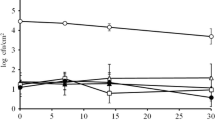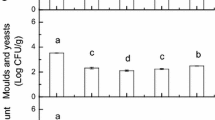Abstract
The purposes of this study were to evaluate the inactivation effects of intense pulsed light (IPL) on indigenous and inoculated microorganisms in fresh and minimally processed foods and the industrial applicability of this nonthermal sterilization method. The samples were treated with IPL by varying the treatment time and voltage. The inactivation effect tended to increase as the treatment conditions increased. Further, indigenous microorganisms showed a lower inactivation level than inoculated microorganisms, E. coli ATCC 25922, due to the variability of indigenous microorganisms and their properties. Chopped garlic showed a higher E. coli inactivation effect (2.65 log reduction after 0.185 J/cm2 of IPL) than peeled garlic (1.21 log reduction) due to its larger surface area. The manila clam showed a lower E. coli inactivation (0.93 log reduction) effect than squid (1.84 log reduction) due to its rougher surface. After the IPL treatment, there was no significant difference in temperature, moisture content, and color.




Similar content being viewed by others
References
Alarcón-Flores MI, Romero-González R, Vidal JLM, González FJE, Frenich AG. Monitoring of phytochemicals in fresh and fresh-cut vegetables: A comparison. Food Chemistry. 142: 392-399 (2014)
Alegbeleye OO, Singleton I, Sant’Ana AS. Sources and contamination routes of microbial pathogens to fresh produce during field cultivation: a review. Food Microbiology. 73: 177-208 (2018)
Anderson JG, Rowan NJ, MacGregor SJ, Fouracre RA, Farish O. Inactivation of food-borne enteropathogenic bacteria and spoilage fungi using pulsed-light. IEEE Transactions on Plasma Science. 28: 83-88 (2000)
Bialka KL and Demirci A. Efficacy of pulsed UV‐light for the decontamination of Escherichia coli O157: H7 and Salmonella spp. on raspberries and strawberries. . Journal of Food Science. 73: M201-M207 (2008)
Bohrerova Z, Shemer H, Lantis R, Impellitteri CA, Linden KG. Comparative disinfection efficiency of pulsed and continuous-wave UV irradiation technologies. Water Research. 42: 2975-2982. (2008)
Cserhalmi Z, Sass-Kiss A, Tóth-Markus M, Lechner N. Study of pulsed electric field treated citrus juices. Innovative Food Science & Emerging Technologies. 7: 49–54 (2006)
Cheigh CI, Hwang HJ, Chung MS. Intense pulsed light (IPL) and UV-C treatments for inactivating Listeria monocytogenes on solid medium and seafoods. Food Research International. 54: 745-752 (2013)
Cheigh CI, Park MH, Chung MS, Shin JK, Park YS. Comparison of intense pulsed light-and ultraviolet (UVC)-induced cell damage in Listeria monocytogenes and Escherichia coli O157: H7. Food control. 25: 654-659 (2012)
Elmnasser N, Guillou S, Leroi F, Orange N, Bakhrouf A, Federighi M. Pulsed-light system as a novel food decontamination technology: a review. Canadian Journal of Microbiology. 53: 813-821 (2007)
Gómez-López VM, Koutchma T, Linden K. Ultraviolet and pulsed light processing of fluid foods, In Novel thermal and non-thermal technologies for fluid foods. Academic Press, pp. 185-223 (2012)
Hierro E, Barroso E, De la Hoz L, Ordóñez, JA, Manzano S, Fernández M. Efficacy of pulsed light for shelf-life ex-tension and inactivation of Listeria monocytogenes on ready-to-eat cooked meat products. Innovative food science and emerging technologies. 12: 275-281 (2011)
Hillegas SL, Demirci A. Inactivation of Clostridium sporogenes in. clover honey by pulsed UV-light treatment, In 2003 ASAE annual meeting. American society of agricultural and biological engineers (p. 1) (2003)
Holck A, Liland KH, Carlehög M, Heir E. Reductions of Listeria monocytogenes on cold-smoked and raw salmon fillets by UV-C and pulsed UV lightInnovative . Innovative Food Science & Emerging Technologies. 50: 1-10 (2018)
Huang R, Chen H. Evaluation of inactivating Salmonella on iceberg lettuce shreds with washing process in combination with pulsed light, ultrasound and chlorine. International journal of food microbiology. 285: 144-151 (2018)
Hwang HJ, Seo JH, Jeong C, Cheigh CI and Chung MS. Analysis of bacterial inactivation by intense pulsed light using a double-Weibull survival model. Innovative Food Science & Emerging Technologies. 56: 102185 (2019)
Kim DH, Lim JJ, Lee JJ, Jang HH, Jang DI, Lee SJ, Lee HJ, Min WG, Kwon SH, Kim, S. H. Bacteriocidal effects of ultraviolet irradiation for reducing bovine mastitis derived from environmental contamination. Korean Journal of Environmental Agriculture. 27: 435-440 (2008)
Kim SM, Hwang HJ, Cheigh CI, Chung MS. Bactericidal effect of intense pulsed light on seeds without loss of viability. Food Science and Biotechnology. 28: 281-287 (2019)
Lasagabaster A, Arboleya JC, De Maranon IM. Pulsed light technology for surface decontamination of eggs: Impact on Salmonella inactivation and egg quality. Innovative Food Science & Emerging Technologies. 12: 124-128 (2011)
Laurila E, Ahvenainen R. Minimal processing of fresh fruits and vegetables. Jongen, W. Fruit and Vegetable Processing. Improving quality. Boca Raton, USA & Cambridge, England. CRC Press & Woodhead Publishing Limited (pp. 288-309) (2002)
Li K, Weidhaas J, Lemonakis L, Khouryieh H, Stone M, Jones L, Shen C. Microbiological quality and safety of fresh produce in West Virginia and Kentucky farmers’ markets and validation of a post-harvest washing practice with antimicrobials to inactivate Salmonella and Listeria monocytogenes. Food Control. 79: 101-108 (2017)
Nicorescu I, Nguyen B, Moreau-Ferret M, Agoulon A, Chevalier S, Orange N. Pulsed light inactivation of Bacillus subtilis vegetative cells in suspensions and spices. Food control. 31: 151-157 (2013)
Oms-Oliu G, Martín-Belloso O, Soliva-Fortuny R. Pulsed light treatments for food preservation. A review. Food and Bioprocess Technology. 3: 13-23 (2010)
Ozer NP, Demirci A, Inactivation of Escherichia coli O157: H7 and Listeria monocytogenes inoculated on raw salmon fillets by pulsed UV‐light treatment. International Journal of Food Science and Technology. 41: 354-360 (2006)
Pareek, S. (Ed.). Fresh-cut fruits and vegetables: technology, physiology, and safety. CRC Press (2016)
Pedrós-Garrido S, Condón-Abanto S, Clemente I, Beltrán J, Lyng J, Bolton D, Brunton N, Whyte P. Efficacy of ultraviolet light (UV-C) and pulsed light (PL) for the microbiological decontamination of raw salmon (Salmo salar) and food contact surface materials. International Journal of Food Science and Technology. 50: 124-131 (2018)
Ramos-Villarroel AY, Martín-Belloso O, Soliva-Fortuny R. Bacterial inactivation and quality changes in fresh-cut avocado treated with intense light pulses. European Food Research and Technology. 233: 395-402 (2011)
Ramos-Villarroel AY, Aron-Maftei N, Martín-Belloso O, Soliva-Fortuny R. The role of pulsed light spectral distribution in the inactivation of Escherichia coli and Listeria innocua on fresh-cut mushrooms. Food Control. 24: 206-213 (2012)
Sharma R, Demirci A. Inactivation of Escherichia coli O157: H7 on inoculated alfalfa seeds with pulsed ultraviolet light and response surface modeling. Journal of Food Science. 68: 1448-1453 (2003)
Takeshita K, Shibato J, Sameshima T, Fukunaga S, Isobe S, Arihara K. Itoh M. Damage of yeast cells induced by pulsed light irradiation. International Journal of Food Microbiology. 85: 151-158 (2003)
Tomašević I. The effect of intense light pulses on the sensory quality and instrumental color of meat from different animal breeds. Biotechnology in Animal Husbandry. 31: 273-281 (2015)
Uesugi AR, Moraru CI, Reduction of Listeria on ready-to-eat sausages after exposure to a combination of pulsed light and nisin. Journal of Food Protection. 72: 347-353 (2009)
Yam KL, Papadakis SE. A simple digital imaging method for measuring and analyzing color of food surfaces. Journal of Food Engineering. 61: 137-142 (2004)
Acknowledgements
This work was supported by Basic Science Research Program through the National Research Foundation of Korea (NRF) funded by the Ministry of Education (NRF-2016R1D1A3B03931649) and Korea Institute of Planning and Evaluation for Technology in Food, Agriculture, Forestry (IPET) through High Value-added Food Technology Development Program, funded by Ministry of Agriculture, Food and Rural Affairs (MAFRA) (317030-3).
Author information
Authors and Affiliations
Corresponding author
Ethics declarations
Conflict of interest
The authors declare that they have no conflict of interest.
Additional information
Publisher's Note
Springer Nature remains neutral with regard to jurisdictional claims in published maps and institutional affiliations.
Rights and permissions
About this article
Cite this article
Hwang, HJ., Park, JY., Chung, MS. et al. Microbial inactivation in fresh and minimally processed foods by intense pulsed light (IPL) treatment. Food Sci Biotechnol 30, 939–948 (2021). https://doi.org/10.1007/s10068-021-00937-5
Received:
Revised:
Accepted:
Published:
Issue Date:
DOI: https://doi.org/10.1007/s10068-021-00937-5




